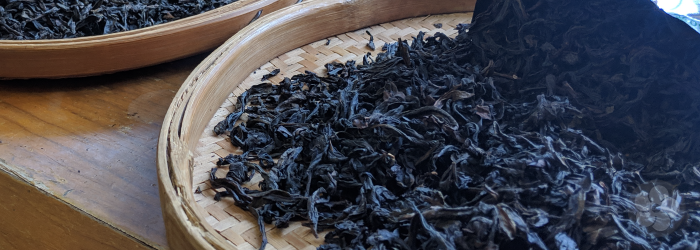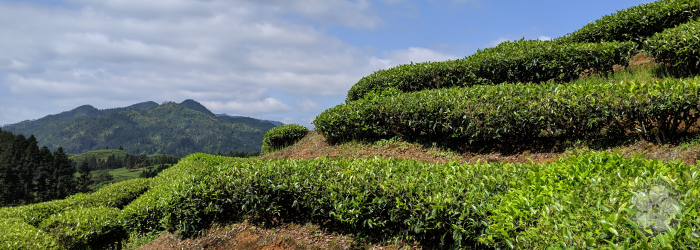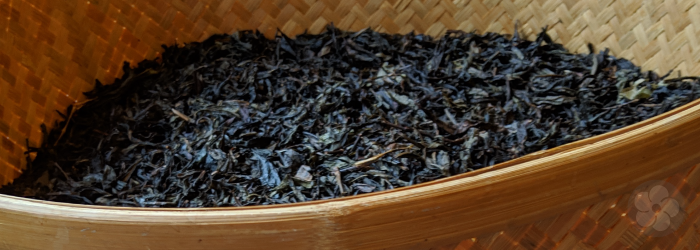What is Da Hong Pao Tea?

As one of the most famously celebrated teas in China, Da Hong Pao (translated as either ‘Big Red Robe’, or more poetically, ‘Grand Scarlet Robe’) is surrounded by myth and legend. While fantastic stories have helped to build this tea’s reputation as a rare and valuable commodity, they say little about the quality of flavor found in any particular leaf. So what makes Da Hong Pao so special, and what does it mean when a product is labeled “Big Red Robe”?
Defining Da Hong Pao
To be specific, Da Hong Pao is a variety of the Camellia sinensis tea plant, just as Cabernet Sauvignon is a variety of wine grapes. Notably, this is believed to be a wild variety, naturally adapted to the rocky cliffs of the Wuyi Mountains in northern Fujian, rather than a cultivated variety created by tea farmers.
Find out more about wild and cultivated varieties of Camellia Sinensis >>
The particular terroir of this area is another key to the famed flavor of this distinct style, with the rocky, iron-rich soil lending unique minerals to the plant during the growth process. Along with other oolongs grown in the same region, this tea is known as yancha, or “cliff tea”, a category defined by characteristic mineral-rich flavor.
Explore yancha with Alice in this video:
Methods of crafting in this region have been perfected over several centuries to complement the natural flavor profile created by native varieties and terroir. Most Wuyi oolong teas are heavily roasted over a charcoal fire to produce a dark color and caramelize the glucose present in the leaf in order to create natural sweetness. Lower grades are roasted with modern convection ovens that make it easier to craft in larger batches.
Learn more about terroir and crafting traditions of oolong teas >>
Origins of Da Hong Pao
Varieties of Camellia sinensis have been found and cultivated throughout China for thousands of years, but only a few have gained true notoriety in the way Da Hong Pao has. Legendary origin stories abound, including many variations, but here are two of the most popular:
A scholar on his way to take the civil service exam stopped to brew some leaves plucked from a wild tea tree. He was the only one in his year to pass the rigorous test, and after being awarded his prestigious red robe, returned to the tea bush to drape the robe over it in thanks.
The Emperor’s mother fell ill, but when he received this tea as a gift, it cured her of her ailment. In thanks, he sent grand red robes to the humble tea farmer to be draped over the tea plants.
Whether any of the many stories holds a grain of truth or not, a handful of ancient tea trees on a cliff in the Wuyi Nature Preserve now attract hordes of tourists. An inscription on the cliff face reads “Da Hong Pao”, touting these trees as the original source of this famous Chinese tea.

For many years, the extremely limited harvest plucked from these trees was reserved for China’s most elite tea drinkers, and was even presented to President Nixon when he visited in 1972. Today, harvesting from these trees has been banned altogether, and “true” Da Hong Pao comes only from descendant plants, derived from cuttings taken long ago.
Three Wuyi varieties are commonly recognized as close relatives of the “original” Da Hong Pao trees: Bei Dou (“North Star”), Que She (“Sparrow’s Tongue”), and Qi Dan, which is thought by some to include a few of the mother trees. All three are claimed as direct descendants of the mother plants, grown and developed from cuttings on tea farms within the Wuyi mountains to preserve the terroir of the original tea.

Modern Da Hong Pao
Ultimately, despite the legends surrounding the lineage of this tea, practical measures of quality typically depend more on terroir and craftsmanship than the name on the tea tin. Indeed, many more common varieties grown in the same area are labeled as Da Hong Pao for the benefit of prestige. Some companies create proprietary blends of various local varieties to create an approximation of the famed flavor profile.
Find out what standards we use to determine tea quality >>
In general, when tasting Da Hong Pao or related teas, we look for a full bodied, toasty flavor with complex flavor notes and a long, lingering finish. We shy away from teas that taste burnt, or over-roasted, as this leads to a sharp, bitter bite, and is often a sign that the roaster was trying to cover for a lack of inherent flavor in the leaf. While a strong roast done properly will mellow into deep nuances of fruit or floral tones over time, a burnt tea will never regain complexity of flavor.

Luckily, the proliferation of mediocre examples bearing the label Da Hong Pao does not mean that this famous tea is a lost cause, only that it takes time and effort to find the high quality crops. By visiting high elevation tea farms and working with craftsmen that understand traditional charcoal firing techniques, we are able to select a high quality range of Wuyi oolongs, including varieties such as the descendant Bei Dou, and even a heritage roasted Da Hong Pao, which we call by the English name Grand Scarlet Robe.
Have you explored the world of Wuyi oolong teas? Does Da Hong Pao rank among your favorite Wuyi varieties? Let us know in the comments below!
Sign up for our newsletter to get blog updates in your inbox!




Comments on this post (1)
Wow another clear, informative, spin free illumination on one of my favorite teas. So refreshing to get the meaningful story in depth without overdecoration. Thank you as I enjoy some of this very tea.
— Anonymous